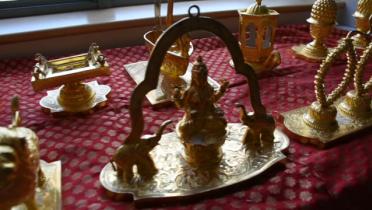Jain Principles and Practices with Mantra
Aarti also spelled arti, arati, arathi, aarthi (In Devanagari: आरती ārtī) is a Hindu religious ritual of worship, a part of puja, in which light from wicks soaked in ghee (purified butter) or camphor is offered to one or more deities. Aartis also refer to the songs sung in praise of the deity, when lamps are being offered.
The most significant mantra in Jainism is the ‘Namokara’ mantra. There is no mention of any particular names of the gods or any specific person in the mantra. The prayer is done towards the guṇa or the good qualities of the gods, saints, teachers, and people. This is the first prayer every Jain learns, as did I.
Whether I am flying on an airplane, or before giving an exam or an interview, or at any moment where I feel I need strength and confidence, I recite the Namokara mantra. The mantra is seared in my brain for the rest of my life.
Translation of the video:
This is aarti. Every morning we do aarti here.
Aarti. (singing)
This is darpan (or mirror). We have to see God in the mirror. So, we have to put it (image of God) in our heart and we have to see the God in our heart. The mirror is the symbol. And we have to wave the fan and see the image of God, then we use the chawar and move it in front of the idol and dance on our feet and pray to the Indra dev and devis every day. Then we pray with the dhoop (candle).
Aarti. (singing)
These are images of devis. This is Saraswati devi, the Goddess of Knowledge. We pray here when we are studying to obtain knowledge. Even for religious knowledge, we have to first pray to Goddess Saraswati. This is Lakshmi devi, Goddess of Wealth. This is Padmavati devi. This is prasvanath bhagwan. This is combination. This is Gautam Swami. You know Gautam Swami?
No.
When Mahavir Bhagwan became a tirthankara, he got Moksha on the same day, on Diwali night.
Can you explain a little bit about this?
When we pray here, this is the yantra. This shows all 24 tirthankars’ names.
And what are the 24 tirthankars?
When we do the puja, this is Rishabh dev, Ajitnath, Sambhavnath, Abhinandannath, Sumatinath, Padmabrabha, Suparshvanath, Chandraprabha, Pushpadanta, Shiatnath, Shreyansanath, Vasupujya, Vimalnath, Anantnath, Dharmanath, Shantinath, Kunthunath, Aranath, Malinath, Munisuvrata, Nami Natha, Neminatha, Parsva Natha, Mahavira.
24 tirthankars names.
This is Chakeshwari devi. Do you know Rishab dev from Palitana? The first tirthankara? This is his protector. So, this is Chakeshwari devi.
And you know the ambi doli?
No.
This yantra is the ambi doli and it comes twice a year every Chaitra month and Asvina month. Sometimes March or sometimes April, sometimes September and sometimes October. Once a day and we have to pray this yantra at that time. This is Shree Manthan Pandan Swami. He is live with us right now. So, once we do lots of punaya (good deeds), then we go to kshetra. He comes live there. So, we pray every day that we come to you. This is Manidhadra dev. Every Thursday we have to pray to him as people believe Thursday is very important for him. So generally, every Thursday someone puts coconut or other offerings at his idol. This is Nagoda dev. He becomes right now in Rajasthan. His teerth name is also Nagoda. He is also a very blessing dev.

